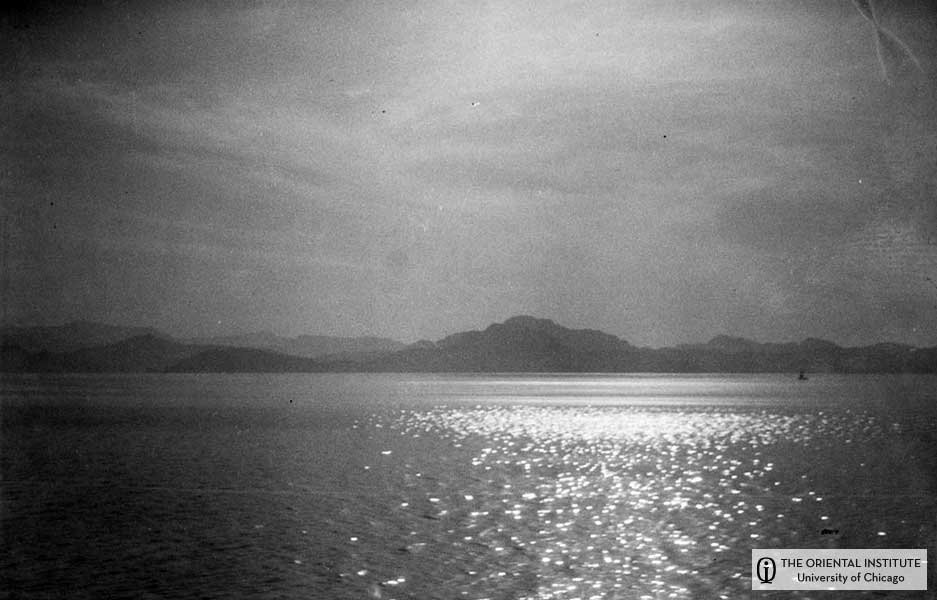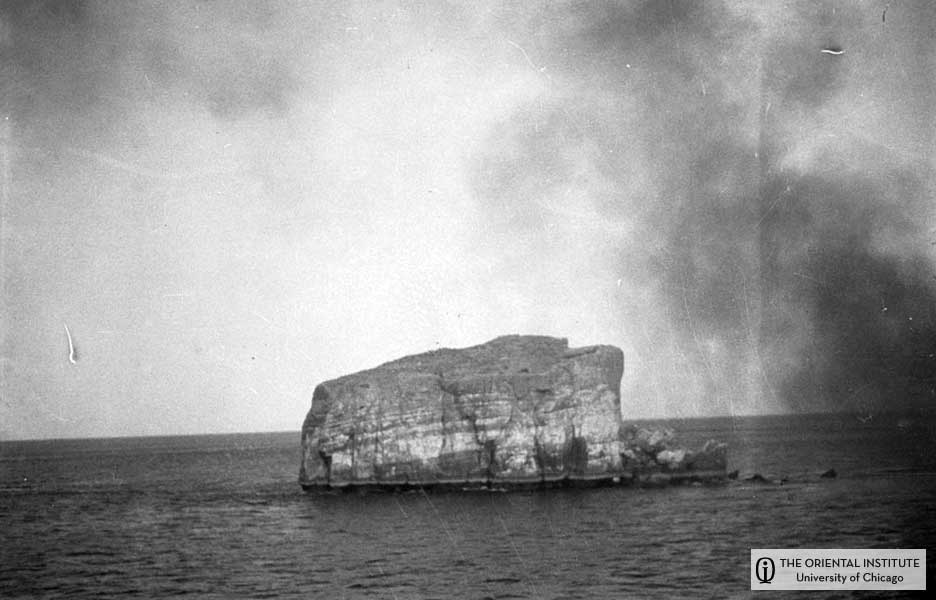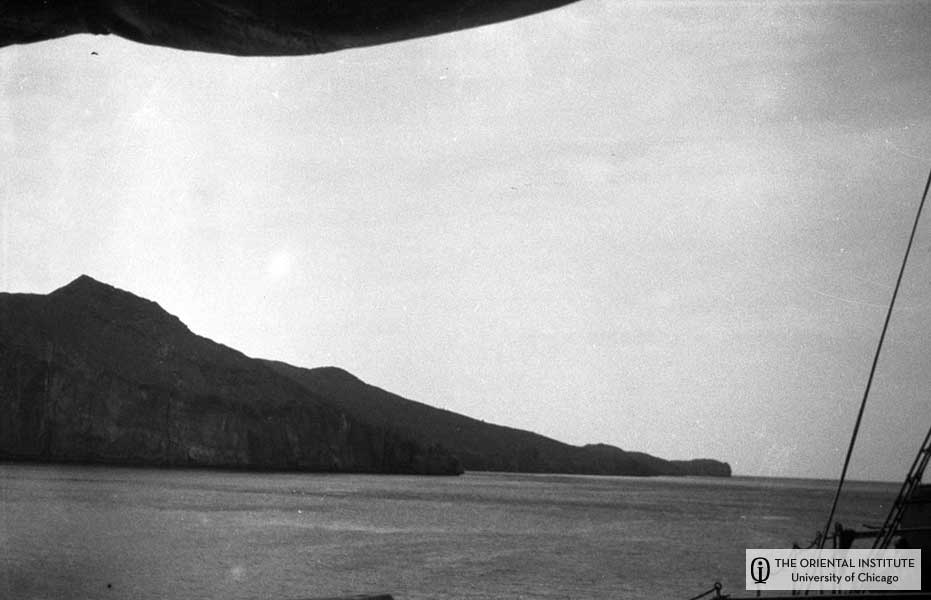Saturday Evening
March 6, 1920
I was unable to write last evening, for a passenger who had come out on the “Benares” gave me away, and the captain, who is an unusually intelligent and well-informed man, together with Bishop Warne, for 32 years bishop of Lucknow, India, came to me and cajoled me into a so-called lecture to the passengers. They seemed to be much interested.
This morning as we looked out of our port-hole, which is on the north side of the ship, we found the coast of Persia forming our northern sky-line. We had expected it, for last evening we were entering the Gulf of Oman amid a display of phosphorescence such as I had never conceived. Wandering lines of light diverged from the prow of the ship on both sides, and as this ridge thrown up by the hull broke into waves sinuous tongues of flame in a luminous ragged fringe shot out from the combing crest of the wave glowing with the bright bluish-green hues of a drift-wood fire. I would have been glad indeed to spend the evening leaning over the rail and contemplating this wonderful and gorgeous display, if they had not involved me in a speech.
 Oman: Mountains in Oman, east of Ras el-Musandam. March 6, 1920. (N. 44564, P. 65804)
Oman: Mountains in Oman, east of Ras el-Musandam. March 6, 1920. (N. 44564, P. 65804)
This morning we could see the life to which the fiery display was due. These waters teem with life. As far as one can see the reddish spawn of fish is visible from the surface deep down into the waters. Sometimes it gathers in a ruddy scum extending far over the surface of the sea, and looking like floating iron rust. It has been supposed that the name Red Sea arose from this phenomenon. Myriads of jelly fish of all sizes, each a vague and filmy circular veil, or sometimes a larger and more elaborate form, went floating by as the ship plowed along. Now and then a water serpent, with bands of black and white squirmed along the surface, or with slow serpentine propulsion, pushed his way straight down and disappeared in the dark depths of the green waters. Twice a large turtle, perhaps two feet across, paddled deliberately out of the way, while here and there schools of small fish could be seen moving rapidly along, ruffling the mirror-like surface of the sea, as if a flurry of wind were passing by. Far out from the ship could be seen the trails of moving creatures leaving a long narrow wake on the surface of the sea, and with the glass it was possible to see the projecting head of some strange creature. Groups of three and four flying fish would rise from the water, when pursued by their enemies, and flying like birds skimming the surface of the sea for forty or fifty yards could at first hardly be distinguished from birds, till they dropped into the water and disappeared. Then the grey-green form of a hammer-headed shark directly alongside and only a foot or two below the surface, suggested what would happen to anybody who fell overboard. I was continually reminded of Doré’s drawing of Milton’s “gorgons and chimaeras dire”, or his sketches of the sea and its life in the Ancient Mariner, as the ship steadily plowed its way through this sea-jungle whose surface betrayed only here and there sinister hints of the vast tragedy which was being unceasingly enacted in its gloomy depths.
 Oman: A rock in the sea, off Ras el-Musandam. The dark cloud is probably smoke from our steamer. March 6, 1920. (N. 44574, P. 65811)
Oman: A rock in the sea, off Ras el-Musandam. The dark cloud is probably smoke from our steamer. March 6, 1920. (N. 44574, P. 65811)
The southern coast of Persia interested me intensely. Desolate pale gray cliffs, which look like limestone, rise directly from the sea, and after we passed the headland of Jashak, or Jashk, the coast ridges westward of Jashk were flanked by distant mountains 6000 to 10,000 feet high. Here and there a rift transverse to the coast had permitted the drainage to bring down a little alluvium, and as we approached he Strait of Ormuz, the mouth of the Persian Gulf, we met one such narrow strip of fore shore where there was a grove of trees among which we cold distinguish the tops of tall palms. Otherwise the entire coast and the hinterland behind it are a desolate desert. I could understand now why Darius failed in his impressive effort to make Persia a maritime nation (see Ancient Times), and Alexander’s terrible march westward along this coast on his return from India, — a march that cost him a large part of his army, as I look out of my port hole to the very coast along which he passed, assumes a reality which it never had before.
This noon we entered the Strait of Ormuz, and just four days out of Bombay, we were in the Strait. The captain did not follow its northern bend, but leaving the coast of Persia, made straight northwest for the projecting coast of Arabia, which you will find on the map marked Ras (Cape) Mussendom.  Oman: Ras el-Musandam, the northernmost point of Oman. The ship is still approaching the point. March 6, 1920. (N. 44568, P. 65806)
Oman: Ras el-Musandam, the northernmost point of Oman. The ship is still approaching the point. March 6, 1920. (N. 44568, P. 65806)
Its backbone is a north and south ridge of imposing mountains which drop abruptly to the sea in rugged and picturesque forms, and continue northward in a straggling group of craggy islands extending many miles out into the strait. For the first time the British government has since the war placed a few lights in the Persian Gulf, and one of them is on one of these islands. It was nearing sunset as we approached them, and the captain boldly steered a course through the islands, thus saving a long detour to the north. A scanty olive green mantle of vegetation, following the rainy season which is now just closing, covered the heights of these rocky islets, past one of which we went so close that you could count the birds perched on its gaunt front, and could almost have thrown a stone against its cliffs. The sea had cut far under the base of the cliffs, and deep and gloomy caverns were for a moment illuminated by the setting sun as we caught momentary glimpses far down their forbidding throats. A gloomier “Toteninsel” I have never seen. At the head of Cape Mussendom a rift in the cliffs displayed a strip of beach, and here stood several people beside a small boat, belonging doubtless to the local fishermen, whose sails we could occasionally discern along the coast. This whole eastern region of Arabia is known as Oman, and supports a scanty Arab population. You may remember Reinhart, whom we met years ago at Franz Pasha’s in Cairo, and recall that he was Consul for years on this coast, where he lost an eye from ophthalmia. This so broke his spirit that he eventually died. He wrote a very useful grammar of the Arabic dialect of Oman, which is the standard book on the subject.
The prospect of these islands and the magnificent headland, touched by the last rays of the setting sun, as we left them behind and looked back upon them, furnished a prospect of sea and land which I shall long remember.
I have just sent off a radio message to Major-General Hambro at Baghdad, and I hope that he will engage accommodations for us at Bosra, which he very kindly volunteered to do in his letter to me at Cairo.
For the full story of my exciting trip you should come to the special exhibit “Pioneers to the Past: American Archaeologists in the Middle East, 1919-1920,” at the Oriental Institute!
1155 East 58th Street Chicago, IL 60637
Hours:
- Tuesday 10:00 am to 6:00 pm
- Wednesday 10:00 am to 8:30 pm
- Thursday 10:00 am to 6:00 pm
- Friday 10:00 am to 6:00 pm
- Saturday 10:00 am to 6:00 pm
- Sunday noon to 6:00 pm
- Closed Mondays
http://oi.uchicago.edu/museum/special/pioneer/
And visit me on facebook at: http://www.facebook.com/profile.php?id=3318774#/profile.php?v=info&ref=profile&id=100000555713577